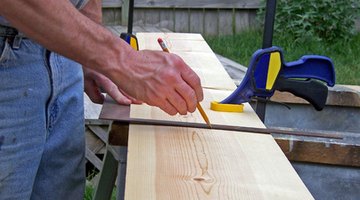How to Read a Carpenter Square
A carpenter's square, also called a framing square, is a versatile instrument for laying out stair stringers, roof rafters and determining angles, among other duties. Usually made from aluminum or steel, carpenter's squares are etched with tables and numbers that go beyond a simple ruler.

These tables are quick references that save builders time by relieving them of the task of making long calculations. Two basic tables are included on most, but not all, carpenter's squares: rafter tables and an Essex board measure.
Identification
-
Hold the square in one hand and examine it. One leg is wider and longer than the other. The wider leg is called the blade, and the narrower one, the tongue. The manufacturer's name and logo is stamped on one side, which is called the face. The flip side is the back. The point where the tongue and blade meet is a 90 degree angle and is referred to as the heel.
-
Look at the markings all along both edges of the blade and tongue, face and back. These increments are nearly always as small as 1/8 inch but often, at least two edges will be divided into 1/16-inch increments.
-
Turn the square so that the back is facing you. Some, but not all squares, are divided into 1/12-inch increments and 1/10-inch increments to make it easier to work with decimals.
Rafter Tables
-
Turn the square so the face is pointing toward you. Look for a table with six rows of numbers and some descriptive words. This is the rafter table and it gives lengths of rafters for one foot of run over a given rise. A run is one-half the span the roof has to cover, the span being the distance from one wall to the other. A rise is the distance upward the roof travels to the top, or ridge.
-
Read the first line, which says something similar to, "Length common rafters per foot run." A common rafter is one that reaches from the wall to the ridge board, or top of the roof. You will also see terms like hip (rafters that extend from the corner where two walls meet up to the ridge), valley (rafters that go from the ridge to a board that marks the intersection of two roof surfaces), and jacks (rafters that do not extend all the way to the ridge).
-
Follow the first row of numbers, those for common rafters. Each number (21 63, 20 81, 20, 19 21...) is lined up under an inch increment along the top of the blade. The inch increment represents the rise of the roof in inches over a foot of run. For example, if the roof rises 8 inches over one foot of run, the roof rafter needs to be 14.42 inches long per foot of run. Multiply 14.42 times the actual length of the run to get the length of the common rafter.
Essex Board Measure
-
Flip the square over so the back is facing toward you. Look for a table with seven rows of numbers lined up under each inch increment. This table is typically not labeled, but it is the Essex board measure and gives the number of board feet in a one-inch-thick board at different lengths and widths.
-
Look at the column of numbers under the 12-inch increment (8, 9, 10... ). Since board feet is calculated by multiplying the width times the length times the thickness of a board, these numbers represent both the length of and the board feet in a 12-inch-wide board.
-
Determine the board feet in a board of a given width by starting at the row under the 12-inch mark. Find the length of the board under the 12-inch mark, then follow it left or right until a number appears under the actual width of the board. For example, to find the board feet in a 10-foot board that's 4 inches wide, find "10" under the 12-inch increment, then follow that row left to the series of numbers under the 4-inch increment, where you'll find the numbers 3 4. The second number is given in 12ths of an inch. So, there are 3 and 4/12 board feet in this board.
The Drip Cap
- A carpenter's square, also called a framing square, is a versatile instrument for laying out stair stringers, roof rafters and determining angles, among other duties.
- Usually made from aluminum or steel, carpenter's squares are etched with tables and numbers that go beyond a simple ruler.
- Turn the square so that the back is facing you.
- Look for a table with six rows of numbers and some descriptive words.
- A rise is the distance upward the roof travels to the top, or ridge.
- Each number (21 63, 20 81, 20, 19 21...) is lined up under an inch increment along the top of the blade.
- Find the length of the board under the 12-inch mark, then follow it left or right until a number appears under the actual width of the board.
- For example, to find the board feet in a 10-foot board that's 4 inches wide, find "10" under the 12-inch increment, then follow that row left to the series of numbers under the 4-inch increment, where you'll find the numbers 3 4.
References
Writer Bio
Robert Korpella has been writing professionally since 2000. He is a certified Master Naturalist, regularly monitors stream water quality and is the editor of freshare.net, a site exploring the Ozarks outdoors. Korpella's work has appeared in a variety of publications. He holds a bachelor's degree from the University of Arkansas.
Photo Credits
- a man marking cut line on lumber image by palms from Fotolia.com
- a man marking cut line on lumber image by palms from Fotolia.com
More Articles



